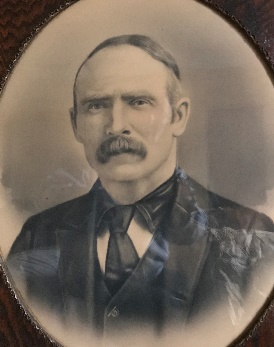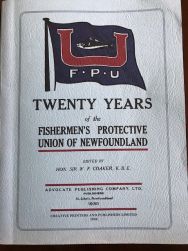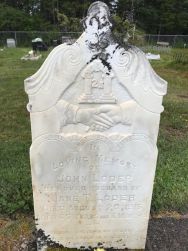John Loder: Difference between revisions
No edit summary |
No edit summary |
||
| (3 intermediate revisions by one other user not shown) | |||
| Line 21: | Line 21: | ||
John Loder of Snook's Harbour was a highly-respected fisherman, skipper and community leader who played a major role in the establishment of the Fishermen's Protective Union (the "FPU") in Trinity Bay in the early 1900s<ref name=Foot01/><ref name=Foot02/> | John Loder of Snook's Harbour was a highly-respected fisherman, skipper and community leader who played a major role in the establishment of the Fishermen's Protective Union (the "FPU") in Trinity Bay in the early 1900s<ref name=Foot01/><ref name=Foot02/> | ||
John was born in the community of Ireland's Eye in either 1850 or 1851<ref name=Foot03/>, one of 8 children of Silas and Rachel (Cooper) Loader. He married Jane Tilley Smith of Elliott's Cove in 1873<ref name=Foot04/> and, after living in Ireland's Eye for a few years, they moved about 30 km inland in Smith Sound to Snook's Harbour. It is believed that John and Jane were the first permanent settlers of the harbour itself<ref name=Foot05/><ref name=Foot06/>. They farmed, fished, logged and ran a general store and sawmill on their property. They had 8 children, one of whom was Martha Isabella who was the first Newfoundlander known to have volunteered for field service during World War I<ref name=Foot07/> [see [[Martha Loder|Notable People]]]. John fished on the French Shore (eastern side of the Great Northern Peninsula) and Labrador Coast with his schooners, including the Mistletoe which was launched from his property in 1900 [see [[Loder]] Family]. It is one of 3 ships which he is cited as having built<ref name=Foot08/>. | {{Multiple image|total_width = 200 | ||
<!-- Layout parameters --> | |||
| align = left | |||
| direction = vertical | |||
| background color = #F8F9FA | |||
| width = | |||
| caption_align = center | |||
| image_style = border:1; | |||
| image_gap = 5 | |||
<!-- Header --> | |||
| header_background = <!-- header background as a 'hex triplet' web color prefixed by # e.g. #33CC00 --> | |||
| header_align = <!-- center (default), left, right --> | |||
| header = <!-- header text --> | |||
<!--image 1--> | |||
| image1 = Coaker_book_cover.jpeg | |||
| width1 = 200 | |||
| alt1 = Front cover of the re-published book on the FPU edited by Sir William Coaker | |||
| link1 = | |||
| thumbtime1 = | |||
| caption1 = Front cover of the re-published book on the FPU edited by Sir William Coaker<ref name=Foot02/> | |||
<!--image 2--> | |||
| image2 = JohnLoder-headstone.jpeg | |||
| width2 = 200 | |||
| alt2 = John Loder's headstone in the Snook's Harbour United Church Cemetery | |||
| link2 = | |||
| thumbtime2 = | |||
| caption2 = John Loder's headstone in the Snook's Harbour United Church Cemetery | |||
<!-- Footer --> | |||
| footer_background = <!-- footer background as a 'hex triplet' web color prefixed by # e.g. #33CC00 --> | |||
| footer_align = <!-- left (default), center, right --> | |||
| footer = <!-- footer text --> | |||
}}John was born in the community of Ireland's Eye in either 1850 or 1851<ref name=Foot03/>, one of 8 children of Silas and Rachel (Cooper) Loader. He married Jane Tilley Smith of Elliott's Cove in 1873<ref name=Foot04/> and, after living in Ireland's Eye for a few years, they moved about 30 km inland in Smith Sound to Snook's Harbour. It is believed that John and Jane were the first permanent settlers of the harbour itself<ref name=Foot05/><ref name=Foot06/>. They farmed, fished, logged and ran a general store and sawmill on their property. They had 8 children, one of whom was Martha Isabella who was the first Newfoundlander known to have volunteered for field service during World War I<ref name=Foot07/> [see [[Martha Loder|Notable People]]]. John fished on the French Shore (eastern side of the Great Northern Peninsula) and Labrador Coast with his schooners, including the Mistletoe which was launched from his property in 1900 [see [[Loder]] Family]. It is one of 3 ships which he is cited as having built<ref name=Foot08/>. | |||
Life was difficult for the fishermen and their families in outport Newfoundland during John's time. Many fishermen were at the mercy of merchants, with supplies and goods given to them on a credit basis each spring, uncertainties in selling prices, and challenges in getting quality fish to distant markets. Determined to improve the lot of outport fishermen in Newfoundland, especially along the Northeast Coast, an energetic visionary named William Coaker (later "Sir William") started the Fishermen's Protective Union in Notre Dame Bay in the fall of 1908<ref name=Foot02/><ref name=Foot09/>. The movement expanded to Bonavista, Trinity and Conception Bays, with John Loder playing a lead role in its establishment in Trinity Bay. John met Sir William at the train station in Clarenville in 1909, was cited as the first to join the FPU in Trinity Bay, organized local Councils of the FPU in various communities in the Bay, and served as the Chairman of the Trinity District Council from 1910 to 1913<ref name=Foot02/>. By the end of 1913, there were local Councils in 37 communities in the Bay, providing strong support for Coaker's pioneering movement and reflecting John's influence. | Life was difficult for the fishermen and their families in outport Newfoundland during John's time. Many fishermen were at the mercy of merchants, with supplies and goods given to them on a credit basis each spring, uncertainties in selling prices, and challenges in getting quality fish to distant markets. Determined to improve the lot of outport fishermen in Newfoundland, especially along the Northeast Coast, an energetic visionary named William Coaker (later "Sir William") started the Fishermen's Protective Union in Notre Dame Bay in the fall of 1908<ref name=Foot02/><ref name=Foot09/>. The movement expanded to Bonavista, Trinity and Conception Bays, with John Loder playing a lead role in its establishment in Trinity Bay. John met Sir William at the train station in Clarenville in 1909, was cited as the first to join the FPU in Trinity Bay, organized local Councils of the FPU in various communities in the Bay, and served as the Chairman of the Trinity District Council from 1910 to 1913<ref name=Foot02/>. By the end of 1913, there were local Councils in 37 communities in the Bay, providing strong support for Coaker's pioneering movement and reflecting John's influence. | ||
| Line 27: | Line 60: | ||
Led by Coaker, the FPU expanded into a political party for the 1913 colonial election in Newfoundland<ref name=Foot01/><ref name=Foot02/><ref name=Foot09/>. John Loder was selected as a candidate for the FPU Political Party but was among 3 FPU candidates who withdrew their candidacy as part of a cooperative strategy with the Liberal Party, in order to obtain stronger representation for outport Newfoundland. This resulted in an alliance government led by Sir Robert Bond, with 8 FPU party members (including Coaker) elected. John Loder and the other 2 withdrawn candidates were subsequently recognized by the FPU as members of its Supreme Council. Coaker referred to John as a "friend" and "esteemed colleague". | Led by Coaker, the FPU expanded into a political party for the 1913 colonial election in Newfoundland<ref name=Foot01/><ref name=Foot02/><ref name=Foot09/>. John Loder was selected as a candidate for the FPU Political Party but was among 3 FPU candidates who withdrew their candidacy as part of a cooperative strategy with the Liberal Party, in order to obtain stronger representation for outport Newfoundland. This resulted in an alliance government led by Sir Robert Bond, with 8 FPU party members (including Coaker) elected. John Loder and the other 2 withdrawn candidates were subsequently recognized by the FPU as members of its Supreme Council. Coaker referred to John as a "friend" and "esteemed colleague". | ||
Unfortunately, John's health started to decline shortly thereafter, and he passed away in Snook's Harbour in August 1916 at age 65 years. Although the FPU Political Party had only modest success, the FPU movement itself was a major step forward in obtaining fair treatment for the outport fishermen of Newfoundland. Considering that Coaker was somewhat of a role model for Joseph Smallwood who became Newfoundland's first Premier after it joined Canada in | Unfortunately, John's health started to decline shortly thereafter, and he passed away in Snook's Harbour in August 1916 at age 65 years. Although the FPU Political Party had only modest success, the FPU movement itself was a major step forward in obtaining fair treatment for the outport fishermen of Newfoundland. Considering that Coaker was somewhat of a role model for Joseph Smallwood who became Newfoundland's first Premier after it joined Canada in 1949, it seems clear that, through his major role in the FPU in Trinity Bay, John Loder's legacy includes a significant contribution to the betterment of outport life in the Random Island area and Trinity Bay in the early 20th century. | ||
==Photo Credits== | ==Photo Credits== | ||
Latest revision as of 13:26, 15 November 2022
John Loder | |
|---|---|
 John Loder | |
| Born | 1850[1] |
| Died | 1916 |
| Occupation | Fisherman, Skipper & Community Leader |
| Known for | Played a major role in the establishment of the Fishermen’s Protective Union (the “FPU”) in Trinity Bay in the early 1900s[2][3]. |
Notable People of Random Island: John Loder[a]
John Loder of Snook's Harbour was a highly-respected fisherman, skipper and community leader who played a major role in the establishment of the Fishermen's Protective Union (the "FPU") in Trinity Bay in the early 1900s[2][3]
John was born in the community of Ireland's Eye in either 1850 or 1851[1], one of 8 children of Silas and Rachel (Cooper) Loader. He married Jane Tilley Smith of Elliott's Cove in 1873[4] and, after living in Ireland's Eye for a few years, they moved about 30 km inland in Smith Sound to Snook's Harbour. It is believed that John and Jane were the first permanent settlers of the harbour itself[5][6]. They farmed, fished, logged and ran a general store and sawmill on their property. They had 8 children, one of whom was Martha Isabella who was the first Newfoundlander known to have volunteered for field service during World War I[7] [see Notable People]. John fished on the French Shore (eastern side of the Great Northern Peninsula) and Labrador Coast with his schooners, including the Mistletoe which was launched from his property in 1900 [see Loder Family]. It is one of 3 ships which he is cited as having built[8].
Life was difficult for the fishermen and their families in outport Newfoundland during John's time. Many fishermen were at the mercy of merchants, with supplies and goods given to them on a credit basis each spring, uncertainties in selling prices, and challenges in getting quality fish to distant markets. Determined to improve the lot of outport fishermen in Newfoundland, especially along the Northeast Coast, an energetic visionary named William Coaker (later "Sir William") started the Fishermen's Protective Union in Notre Dame Bay in the fall of 1908[3][9]. The movement expanded to Bonavista, Trinity and Conception Bays, with John Loder playing a lead role in its establishment in Trinity Bay. John met Sir William at the train station in Clarenville in 1909, was cited as the first to join the FPU in Trinity Bay, organized local Councils of the FPU in various communities in the Bay, and served as the Chairman of the Trinity District Council from 1910 to 1913[3]. By the end of 1913, there were local Councils in 37 communities in the Bay, providing strong support for Coaker's pioneering movement and reflecting John's influence.
Led by Coaker, the FPU expanded into a political party for the 1913 colonial election in Newfoundland[2][3][9]. John Loder was selected as a candidate for the FPU Political Party but was among 3 FPU candidates who withdrew their candidacy as part of a cooperative strategy with the Liberal Party, in order to obtain stronger representation for outport Newfoundland. This resulted in an alliance government led by Sir Robert Bond, with 8 FPU party members (including Coaker) elected. John Loder and the other 2 withdrawn candidates were subsequently recognized by the FPU as members of its Supreme Council. Coaker referred to John as a "friend" and "esteemed colleague".
Unfortunately, John's health started to decline shortly thereafter, and he passed away in Snook's Harbour in August 1916 at age 65 years. Although the FPU Political Party had only modest success, the FPU movement itself was a major step forward in obtaining fair treatment for the outport fishermen of Newfoundland. Considering that Coaker was somewhat of a role model for Joseph Smallwood who became Newfoundland's first Premier after it joined Canada in 1949, it seems clear that, through his major role in the FPU in Trinity Bay, John Loder's legacy includes a significant contribution to the betterment of outport life in the Random Island area and Trinity Bay in the early 20th century.
Photo Credits
All provided or taken by John W Loder
Notes
- ↑ Prepared by John W Loder (JohnWLoder@gmail.com) who is a great grandson of John Loder of Snook's Harbour and has done extensive research on the history of the Loders of Random Island
References
- ↑ 1.0 1.1 John Loder's headstone in the Snook’s Harbour United Church Cemetery indicates that he died on 20 August 1916 at age 65 yrs, 8 mos (see photo in text), suggesting that he was born in December 1850. On the other hand, baptism records from the Trinity Anglican Church, on-line at the Newfoundland's Grand Banks genealogical site (see ref 4), indicate that he was born on 18 September 1851. Thus, his birth date is uncertain (it may be that he was baptized on the later date).
- ↑ 2.0 2.1 2.2 "John Loder". Encyclopedia of Newfoundland. p. 357.
- ↑ 3.0 3.1 3.2 3.3 3.4 3.5 Coaker, W.F. (1930). Twenty Years of the Fishermen’s Protective Union of Newfoundland. St John's: Advocate Publishing Company Ltd. p. 395.
- ↑ "Newfoundland's Grand Banks – Genealogical and historical data for the Province of Newfoundland and Labrador".
- ↑ Martin, Wilfred B.W. (1990). Random Island Pioneers. St. John's: Creative Publishers. p. 268.
- ↑ "Snook's Harbour". Encyclopedia of Newfoundland. p. 226.
- ↑ Duley, Margot I. NURSE MARTHA ISABEL LODER (1884-1963) AND THE GREAT WAR: From Snook’s Harbour to the Somme. Part One (PDF). The Newfoundland Historical Society. pp. 46–53.
- ↑ Evans, Calvin D. (2013). Master Shipbuilders of Newfoundland and Labrador. Vol 1: Cape Spear to Boyd’s Cove. St John's: Breakwater Books. p. 306.
- ↑ 9.0 9.1 Smallwood, J.R. (1927). Coaker of Newfoundland. St John's: Advocate Press. p. 101.

